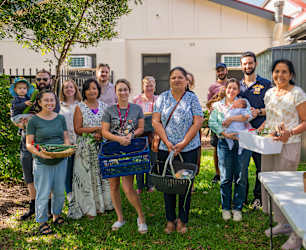Edible seaweed comes from the marine environment and is classed as algae – red, green or brown. There are thousands of species of seaweeds, and humans routinely eat hundreds of them.
Traditionally eaten by coastal cultures including China, Korea and Japan, as well as Europe and Scandinavia, they are rich in vitamins and minerals including iodine, iron and calcium and high in plant protein and fibre. Some is harvested and sold fresh, but most is sold in a dried form.


Prominent edible seaweeds include sea lettuce, sea grapes (aka Neptune’s necklace), nori, agar-agar (used as a vegetarian alternative to gelatine), dulse, sea parsley, kelp, kombu and wakame.
First Nations use
Although little is known about the use of seaweed by Australian First Nations people, research in this area conducted jointly by the University of Exeter and Deakin University concluded that this is likely due to early dispossession of coastal lands and lack of colonists regard for traditional knowledge, rather than lack of use for a range of purposes, including food.
The research found that many coastal communities had known words for seaweed. One species that was documented as a food source used by Indigenous Tasmanians was bull kelp. It was sun-dried, roasted over a fire (able to be preserved at this point) and soaked in freshwater for 10-12 hours for eating.
The authors recommend exploring Indigenous seaweed use further using oral histories, contemporary ancestral knowledge and the potential involvement of Indigenous communities in the development of farmed seaweed as part of our aquaculture industry.
Nutrition and contemporary use in western cultures
Seaweed is not foremost in the minds of most Australians as a regular part of our contemporary diet. Some reasons for this include lack of recipes, little knowledge of preparation and the unusual and idiosyncratic taste, smell and texture. Perhaps also the name ending in -weed doesn’t help. Though gradually, with the introduction of seaweed into familiar products like crackers and other snacks, and the increasing popularity of Japanese cuisine, we are becoming more familiar with it.
The taste is rich, savoury and slightly salty. Many seaweeds are high in vitamins A, B, C and E, iodine and other minerals. Marine foods, including seaweed, are the best sources of iodine, an essential trace element for thyroid regulation (more information including recommended daily intake is available here). It is also good for gut health.
According to the Thyroid Foundation, iodine deficiency is the most common cause of thyroid disorders. Iodine is a naturally occurring chemical which is uniformly present in seawater. However, iodine levels in soils in Australia are very low, meaning we may not be able to rely on our vegetables, grains and livestock to provide us with our iodine requirements. You can read more here.
Author of On Food and Cooking: An encyclopedia of kitchen science, history and culture, Harold McGee explains that seaweed brought about a breakthrough in our knowledge of taste. In the early 1900s, a Japanese chemist discovered that kombu (a brown algae used as a stock base in Japan) is a rich source of naturally occurring MSG, and that MSG provokes a umami, or rich savoury flavour. The west caught up with the concept of umami in the early 2000s.
Foraging Australian seaweed
Common types of edible seaweed found in Australia include sea lettuce, Neptune’s necklace, golden kelp and deadman’s fingers. Wakame is also found in Australia although it is not native and is highly invasive, displacing native habitats by forming dense forests.
Foraging guru Diego Bonetto advises the legalities and ethics of collecting seaweed for personal use.
“Never pull seaweed from their holdfast [anchor]," he says.
"They are a vital element in marine ecosystems.”
It's better to harvest seaweed from the beach or floating in the water. Also, be aware of the quality of water you are collecting from. Read more here.
Where to buy
Your local Asian grocer is the best source of a range of edible seaweed such as nori, kelp, kombu, arame, wakame and more.
Phycohealth is a South Coast business that aims to make the nutritional benefits of seaweed available to the broader community. Founder Dr Pia Weinberg, a marine ecologist, began researching the nutritional benefits of seaweed about 20 years ago. She was interested in a sustainable, low emissions way to grow food from coastal and marine zones. She discovered a species of seaweed and found a way to farm it sustainably.
Dr Weinberg has undertaken clinical trials to support the human health benefits as well as the environmental benefits of growing seaweed. You can find Phycohealth products here.
According to the Australian Seaweed Institute, a seaweed industry provides the most sustainable form of agriculture on the planet and it is now recognised as a superfood. It provides the opportunity to improve the health of our bays, oceans and reefs, provide jobs and assist to mitigate carbon emissions.
Further uses
Nagi Maehashi from RecipeTinEats explains that kombu kelp forms the basis of dashi, a stock which forms the basis of hundreds of Japanese dishes. Although it is possible to make it from scratch, Nagi advocates to use instant dashi in powder form, which is available from the supermarket and Asian grocers.
Ichiban dashi translates to “first stock” and is used to make soups and stews. It consists of a piece of dried kombu, which is softened in simmering water then removed before it boils. Bonito flakes (dried fish) are added, and the liquid strained. You can find the recipe here.
For fans of The Cook Up with Adam Liaw on SBS, an episode that aired on September 24, 2021, was all about cooking seaweed.
Try this recipe, also from SBS's Adam Liaw, which uses broken up nori sheets in an old favourite – salt and pepper tofu.






